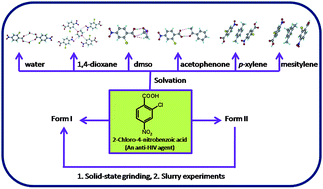Solvates and polymorphic phase transformations of 2-chloro-4-nitrobenzoic acid†
Abstract
A previously unknown monohydrate and five solvates of an

* Corresponding authors
a
Institute of Chemical and Engineering Sciences, A*STAR (Agency for Science, Technology and Research), 1, Pesek Road, Jurong Island, Singapore
E-mail:
srinivasulu_aitipamula@ices.a-star.edu.sg
b
Department of Chemical & Biomolecular Engineering, National University of Singapore, 4 Engineering Drive 4, Singapore
E-mail:
reginald_tan@ices.a-star.edu.sg
A previously unknown monohydrate and five solvates of an

 Please wait while we load your content...
Something went wrong. Try again?
Please wait while we load your content...
Something went wrong. Try again?
S. Aitipamula, P. S. Chow and R. B. H. Tan, CrystEngComm, 2011, 13, 1037 DOI: 10.1039/C0CE00361A
To request permission to reproduce material from this article, please go to the Copyright Clearance Center request page.
If you are an author contributing to an RSC publication, you do not need to request permission provided correct acknowledgement is given.
If you are the author of this article, you do not need to request permission to reproduce figures and diagrams provided correct acknowledgement is given. If you want to reproduce the whole article in a third-party publication (excluding your thesis/dissertation for which permission is not required) please go to the Copyright Clearance Center request page.
Read more about how to correctly acknowledge RSC content.
 Fetching data from CrossRef.
Fetching data from CrossRef.
This may take some time to load.
Loading related content
